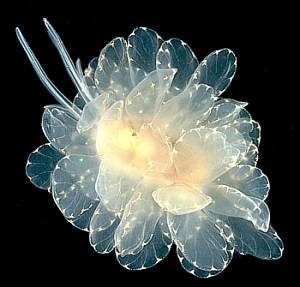
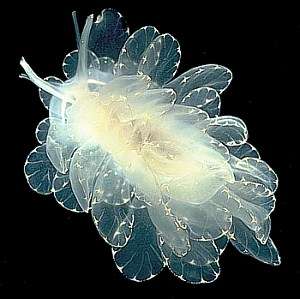
Cyerce elegans
Bergh, 1870
Order: SACOGLOSSA
Superfamily: LIMAPONTIOIDEA
Family: Caliphyllidae
DISTRIBUTION
Originally described from the Sulu Sea and more recently from Hawaii, I have observed it in New Caledonia and on the east coast of Australia. Bergh illustrates a `variety' from Mauritius, and identical specimens I have from east Africa suggest a wide Indo-West Pacific distribution.
PHOTO
off Koumac, New Caledonia, 10m, Sand and grey mud, October 1993, 48mm long alive. PHOTO: Bill Rudman.
These amazingly shaped sacoglossans have large flattened leaf-like 'cerata' which are easily cast-off if the animal is disturbed. This cryptic species resembles a brown algal plant, while others, like the brilliantly coloured Cyerce nigricans, appear to have evolved aposematic warning colouration. In the lower photo the head and bifurcate enrolled rhinophores are clearly visible.
Reference:
• Bergh, L.S.R. (1870). Malacologische Untersuchungen. In: C.G. Semper, Reisen im Archipel der Philippinen, Wissenschaftliche Resultate. Band 2, Heft 1: 1-30, Pls. 1-8.
Rudman, W.B., 1999 (June 22) Cyerce elegans Bergh, 1870. [In] Sea Slug Forum. Australian Museum, Sydney. Available from http://www.seaslugforum.net/find/cyereleg
Related messages
Pale Cyerce elegans from Heron Island
December 6, 2007
From: Julie Marshall
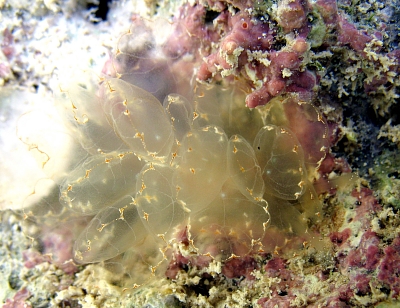
Dear Bill,
Attached is a photo of Cyerce elegans found recently at Heron Island [Great Barrier Reef]. The animal was one of a pair found under a dead coral slab at the reef crest at low tide. The photo shows the very inflated nature of the cerata. The only other C. elegans I have found at Heron Island before was pale red.
Locality: Heron Island, Intertidal, Queensland, Australia, Pacific Ocean, 23 November 2007, Intertidal. Length: 20 mm. Photographer: Julie Marshall.
Best wishes,
Julie Marshall
juliegm@gmail.com
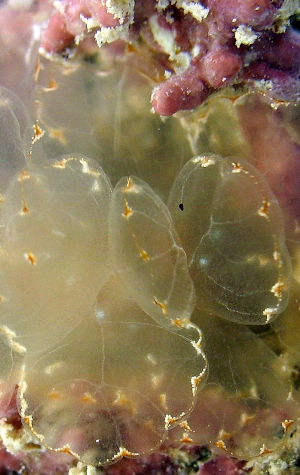
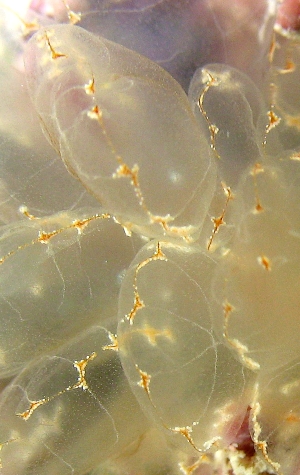
Dear Julie,
Thanks for this photo. It shows the shape - and volume - of the cerata so well I couldn't resist including a couple of close-ups.
Best wishes,
Bill Rudman
Cyerce elegans from West Papua
November 2, 2006
From: Roland Chia
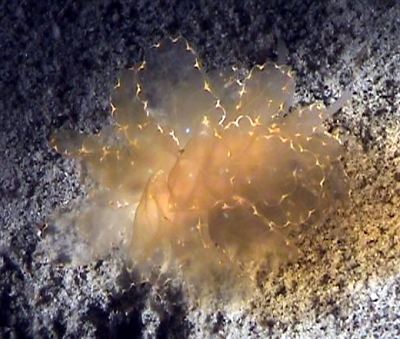
I have send the video still to Neville Coleman, however, he told me that this nudibranch is described to genus, and not to species. He gave me the following information and told me this may be an undescribed species:
FAMILY: Polybranchidae.
COMMON NAME: Scalloped Cyerce
SCIENTIFIC NAMES: Cyerce sp.
My operations director, Roger Koh, was the one who shot the video during a night muck dive near the Biak harbour (West Papua, Indonesia).
Locality: Biak City Harbour, 8 metres, Papua, Indonesia, Cenderawasih Bay, 10 November 2005, Muck area, City Harbour. Length: 45 to 50mm. Photographer: Roger Koh.
Hope you may shed some light on this.
Regards
Roland Chia
www.swanido.com
roland@swanido.com
Chia, R., 2006 (Nov 2) Cyerce elegans from West Papua. [Message in] Sea Slug Forum. Australian Museum, Sydney. Available from http://www.seaslugforum.net/find/17260Dear Roland,
This is indeed a species of Cyerce, but rather than being unnamed, it has had a name, Cyerce elegans, since 1870. As I have said many times before, I am not in favour of Neville's 'common names', which are usually his inventions and not in common use. [see Common names- should we use them?]
Best wishes,
Bill Rudman
Cyerce elegans from the Philippines
May 29, 2002
From: Erwin Köhler
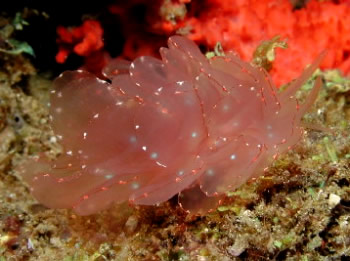
Dear Bill,
Attached is a shot of a Cyerce elegans from the Philippines, Negros Oriental Island, "El Dorado" housereef, nightdive.
Data:
Size - 5cm
Depth - 11m
Date - 04.March 2002
Erwin
Erwin@medslugs.de
Köhler, E., 2002 (May 29) Cyerce elegans from the Philippines. [Message in] Sea Slug Forum. Australian Museum, Sydney. Available from http://www.seaslugforum.net/find/6902Thanks Erwin,
'elegans' is indeed a very appropriate name for this animal.
Cheers,
Bill Rudman
Information on Cyerce elegans
December 30, 2000
From: Debbie W.
I recently just discovered this site in pursuit to discover an unknown species that i received in some live sand for my newly cycled marine reef. I found it here. I would like to have a little more information on this creature like parameters and feeding. But I also noticed that my Cyerce elegans has a green color to it not red or the white. Would it be the same species? And is it aggressive or what can I keep with this little guy? It seems to spend a lot of time on the neptune shaving brush. Is it eating that? any information would be helpful.
Thank you.
Debbie
DEBB110471@aol.com
Debbie W., 2000 (Dec 30) Information on Cyerce elegans. [Message in] Sea Slug Forum. Australian Museum, Sydney. Available from http://www.seaslugforum.net/find/3285Dear Debbie,
If your animal is a different colour then it may not be this species. If it is green then perhaps it is Polybranchia orientalis. I guess the 'Neptune's shaving brush' you mention is a green algae. Both Cyerce and Polybranchia are herbivores so ifyour animal is spending a lot of time on it I guess it could be feeding.
These animals are not agressive, and if you don't mind it eating the 'Neptune's shaving brush' then it will probably live quite happily in your tank.
Best wishes,
Bill Rudman
Re: Cyerce elegans
July 2, 1999
From: Cory Pittman
Dear Bill,
At different times in fall, 1997, I wound up holding a couple of large Cyerce elegans for several (6-10?) days under aeration in a covered container that insured almost complete darkness. They were collected at depths of 11 to 20 m from Halimeda opuntia beds on Maui, Hawaii. When they were collected, they were nearly transparent, i. e., comparable to your top photos. However, while held, they gradually developed an extensive frosting of minute, brown flecks becoming nearly opaque by the time I passed them on to Pauline or preserved them. From memory, I would guess that they became about 1/2 to 2/3 as dark as the photos in Erwin Koehler's message. Of course, I don't know whether they were responding to low light, lack of food, temperature differences or whatever.
Best wishes,
Cory
cory@cet.cet.com
Thanks Cory,
Although it doesn't 'prove' the two are one species it's a useful bit of supporting information.
Was it just chance that you kept them in a covered container or were you wondering if they might have some plastid symbiosis? I always try to keep potential algal symbionts in the dark for a few days to see what might happen - usually with little result. Most Cyerce species looks just right for plastid symbiosis, with large flattened 'cerata' like the photosynthetic Phyllodesmium longicirrum, but in Cyerce the digestive gland doesn't extend into the flattened part of the cerata and there is no evidence of palstid symbiosis. However Caliphylla mediterranea, like species of Polybranchia, has branches of the digestive gland in the cerata and has functional plastid symbiosis.
It was interesting that you mentioned finding them in Halimeda opuntia beds as Ortea & Templado (1990) suggest that Halimeda opuntia is the possible food of Cyerce verdensis (Cape Verde Islands) and Cyerce habanensis (Caribbean).
Ortea, J. & Templado, T. (1990) A new species of the genus Cyerce Bergh, 1871, from the Cape Verde Islands (Opisthobranchia: Ascoglossa). The Veliger, 33(2): 202-205.
Bill Rudman.
Rudman, W.B., 1999 (Jul 2). Comment on Re: Cyerce elegans by Cory Pittman. [Message in] Sea Slug Forum. Australian Museum, Sydney. Available from http://www.seaslugforum.net/find/1008Re: Cyerce elegans from Heron Island
June 29, 1999
From: Julie Marshall
In answer to your question yesterday I have only found the red colour form of Cyerce elegans at Heron Island - and that species only once.
Best wishes,
Julie
j.marshall@bl1.lib.latrobe.edu.au
Marshall, J., 1999 (Jun 29) Re: Cyerce elegans from Heron Island. [Message in] Sea Slug Forum. Australian Museum, Sydney. Available from http://www.seaslugforum.net/find/990Cyerce elegans from Great Barrier Reef
June 28, 1999
From: Julie Marshall
Dear Bill,
I have also found the red colour form of Cyerce elegans (as illustrated last week in the Slug Forum) at Heron Island, Great Barrier Reef. It was 22 mm in size and found under a dead coral slab at the reef crest at low tide in December. The specimen is lodged in the Museum of Victoria.
Julie Marshall
j.marshall@latrobe.edu.au
Marshall, J., 1999 (Jun 28) Cyerce elegans from Great Barrier Reef. [Message in] Sea Slug Forum. Australian Museum, Sydney. Available from http://www.seaslugforum.net/find/983Thanks Julie,
Have you by chance found the paler 'typical' form which I have photos of at the Top of the Page?
Bill Rudman.
Cyerce elegans from Philippines
June 22, 1999
From: Erwin Koehler
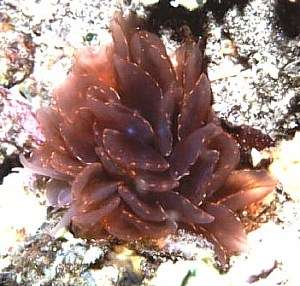
Bill,
attached 3 photos by Georg Heinze (no e-mail):
Nov. 1998, Philippines, Negros Is., divesite Dauin, nightdive; depth ~ 6 m, size ~ 3 cm.
I think it is Cyerce, but don't know which species.
Erwin
Medslugs.Koehler@t-online.de

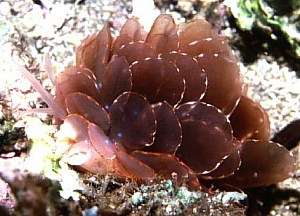
Dear Erwin,
Yes it is a species of Cyerce - C. elegans. It ranges from the quite dark colour in Georg Heinz's photos to the almost transparent colour in my photos at the Top of the Page. It probably reflects part of the feeding cycle as the colour is internal. One distinctive feature, more easily visible in darker animals, is the blue spot near the base of each ceras.
Bill Rudman.
Re: Cyerce elegans
June 22, 1999
From: Clay Carlson
Bill,
Might be wise to add a 'cf' to the Cyerce elegans identification. I have seen/photographed the same species in the same PI area. The color comes from an external dusting of red pigment.
Clay.
Merizo,
Guam.
clay.carlson@kuentos.guam.net
Carlson, C. & Hoff, P.J., 1999 (Jun 22) Re: Cyerce elegans. [Message in] Sea Slug Forum. Australian Museum, Sydney. Available from http://www.seaslugforum.net/find/969